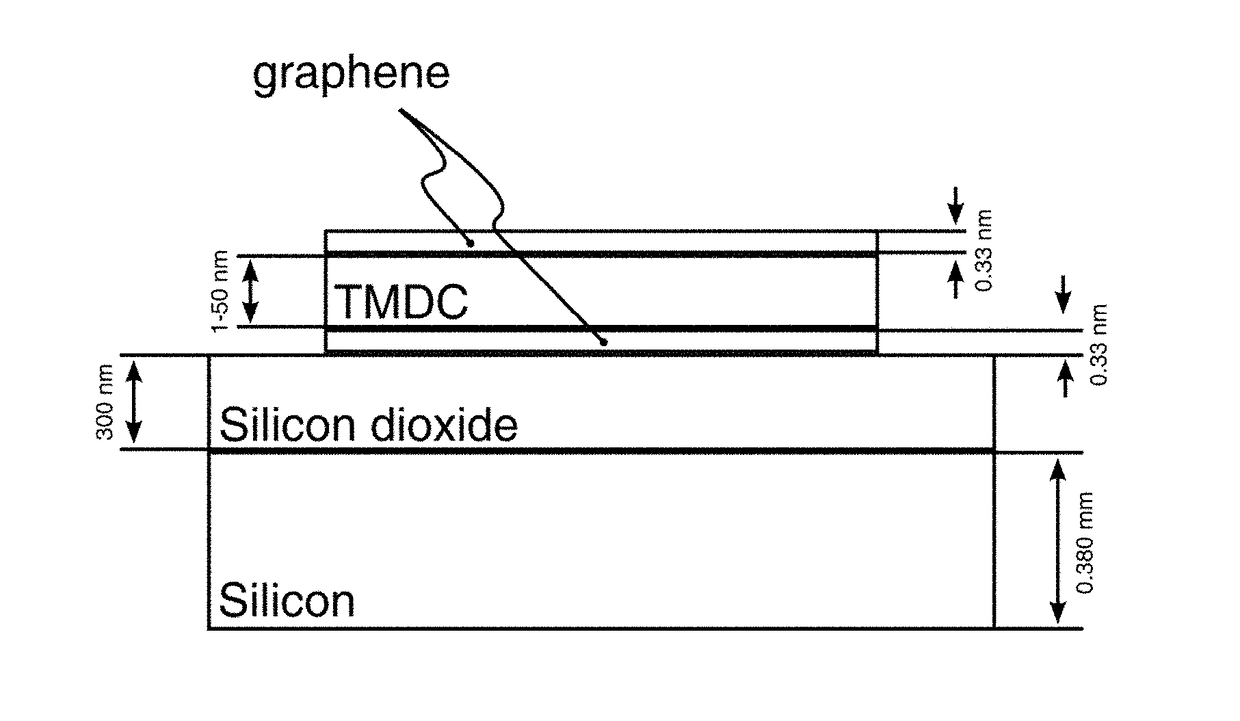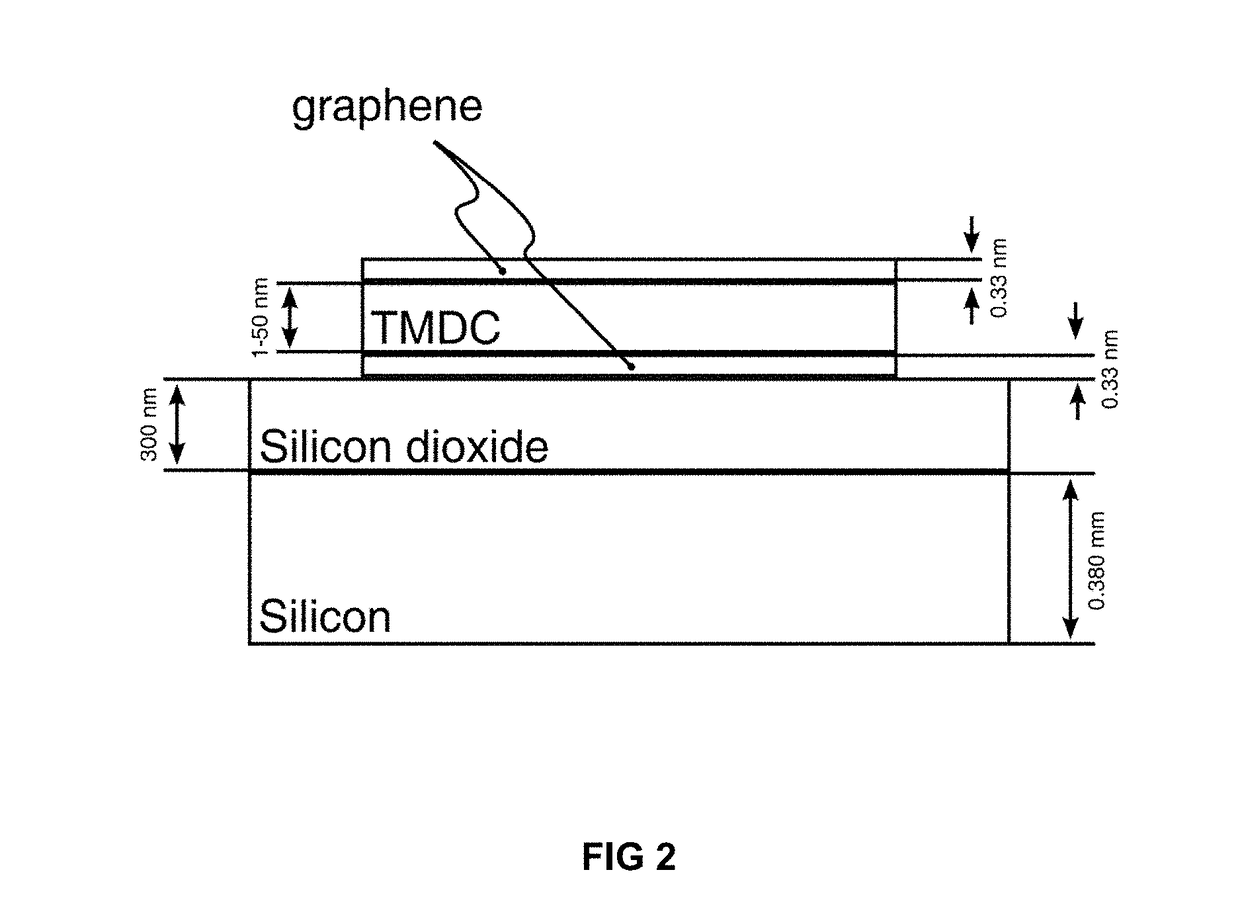Photovoltaic cells
a photovoltaic cell and photovoltaic technology, applied in the field of photovoltaic cells, can solve the problems of high conductivity of graphene, non-linear optical crystals, bulky and expensive, etc., and achieve the effects of dramatic enhancement of local electric fields, increased signal strength, and increased cell signal strength
- Summary
- Abstract
- Description
- Claims
- Application Information
AI Technical Summary
Benefits of technology
Problems solved by technology
Method used
Image
Examples
example 2
on of a Device of the Invention Using Solution Processed Materials
[0202]An alternative exemplary method of preparing the devices, cells and heterostructures according to the invention is as follows.[0203]1. Metal electrodes (Cr / Au (5 / 50 nm) in our case) are patterned onto a substrate (in this case silicon / silicon dioxide).[0204]2. A WS2 film is prepared as follows.[0205]a. WS2 powder is put into a 35% ethanol / water mixture and placed in an ultrasonic bath for 5 days to break up the WS2 crystals to few layer nanoplatlets which form a suspension.[0206]b. The suspension is filtered through a cellulose membrane and a film is left, attached to the filter.[0207]c. By dipping the membrane in water, a thin film (˜50 nm thick) delaminates from the WS2 film and is left floating on the water's surface.[0208]3. The membrane can be ‘fished’ from the water with the gold patterned substrate so that the WS2 film covers many metal electrodes.[0209]4. CVD graphene can then be transferred as previousl...
example 3
on of a Flexible Device
[0211]A device as prepared in Example 1 was transferred to a PET (poly(ethylene terephthalate)) substrate and subjected to strain. As the device was put under strain, it's performance as a transistor was measured and it was found that there was no change of the current with a strain of up to about 5%. It was also shown that it is still possible to modulate the current when the device is under strain.
After it was subjected to strain, the photovoltaic properties of the device were tested as for the Si / SiO2 device described above.
[0212]The inset of FIG. 7 shows the photocurrent of the flexible device (inset, as crossed squares) after it has been placed under strain measured with a 1.95 eV laser as a function of intensity and follows a sublinear dependence.
[0213]In general, the EQE in our devices on Si / SiO2 substrate is somewhat higher in comparison with the flexible PET devices due to multiple reflections in SiO2 which effectively works as a cavity and increases ...
example 5
on and Photovoltaic Ability of Devices Incorporating Gold Nanostructures
[0215]Two devices which incorporate a gold nanostructure were prepared:
A) A 1 nm thick gold film was thermally evaporated onto a pre-existing graphene / WS / graphene device which had previously been seen to exhibit a photovoltaic signal (the device of Example 1). The nanostructures in this case are self-forming as the gold (in the form of Cr / Au (5 / 50 nm)) does not make a continuous layer but instead forms islands. The signal was seen to increase by a factor of up to 15 following this procedure (FIG. 8).
B) A second device type was made (according to the method described in Example 1) in which the photoactive part of the device had two regions: one area where nanostructures were fabricated and one without. The structures are patterned using lithographic techniques. In this case the gold (in the form of Cr / Au (5 / 50 nm)) dots (disks) have a diameter of 150 nm and a pitch of 350 nm. The average photocurrent was greatly ...
PUM
| Property | Measurement | Unit |
|---|---|---|
| thick | aaaaa | aaaaa |
| diameter | aaaaa | aaaaa |
| diameter | aaaaa | aaaaa |
Abstract
Description
Claims
Application Information
 Login to View More
Login to View More - R&D
- Intellectual Property
- Life Sciences
- Materials
- Tech Scout
- Unparalleled Data Quality
- Higher Quality Content
- 60% Fewer Hallucinations
Browse by: Latest US Patents, China's latest patents, Technical Efficacy Thesaurus, Application Domain, Technology Topic, Popular Technical Reports.
© 2025 PatSnap. All rights reserved.Legal|Privacy policy|Modern Slavery Act Transparency Statement|Sitemap|About US| Contact US: help@patsnap.com



